Lebanese Traditions
Lebanon (in Arabic Lubnān) is a republic in Western Asia. Lebanon is located on the shore of Mediterranean sea. It has an area of 10,452 square kilometers. Lebanon has a population of 4,140,289 (2011 estimate). About 10 million Lebanese people live outside Lebanon.
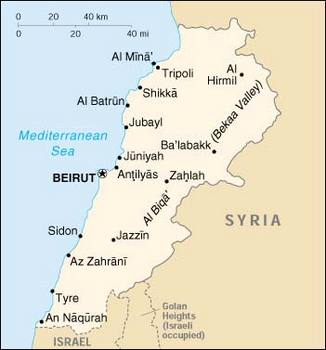 Map of Lebanon
Map of Lebanon
There are different theories about the origin of word Lebanon. Some say it is derived from Aramaic word "lbn" which means "white". It is believed that it is because of the snow covered Mount Lebanon (in Arabic Jabal Lubnan) which extends across the country. Its highest peak is Qurnat as Sawda' (3,088 m).
The second theory sees the origin of the word Lebanon in Syriac which is a dialect of Middle Aramaic language. In Syriac word Lebanon could be translated as "the heart of God" ( "leb" is heart, (a)non is God).
One of main symbols of the country is the Lebanon Cedar (Cedrus libani). It grows in Western Asia (Lebanon, Syria, parts of Turkey). Its variation exists in Cyprus, Algeria and Morocco.
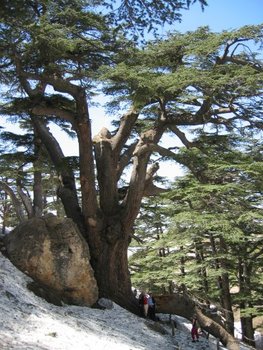 Lebanon Cedar
Lebanon Cedar
This cedar is an evergreen coniferous tree. It can reach the height of up to 40 m. Its trunk can have diameter of up to 2.5 m. The Lebanon Cedar can be seen on the Lebanese flag and coat-of-arms. There is also a legend stating that the cedar from Lebanon was used to build the King Solomon's temple.
 Flag of Lebanon
Flag of Lebanon
Lebanon is a country where the oldest, continuously populated city in the world is located. Byblos or Jbeil, as it is known today, is at least 7000 years old. Phoenicians used to believe that the city was founded by the god El.
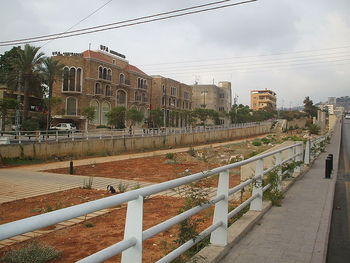 Jbeil (Byblos)
Jbeil (Byblos)
Lebanon has both Islamic and Christian population. The official language of Lebanon is Arabic. The Arabic spoken in this country belongs to the group of dialects known as Levantine Arabic. French, Armenian, Greek and English are spoken too. In everyday life many people actually speak some combination of these languages. The most common combination is the Arabic-French one.
Lebanon has rich history, numerous traditions and traditional products. One of them is the olive soap. It is made with olive oil. It is known for its quality and moisturising characteristics. The Lebanese believe that it is good for curing eczema, dandruff etc. Parts of Lebanon especially famous for olive soap are Hasbaiya, Saida, Chouf and Koura. Soaps are traditionally sold in small shops or souks.
Villages of Assia and Rachaiya El-Foukhar are known for their beautiful handmade pottery. The Lebanese hammered brass and copper trays are made in various parts of the country. They vary in shape and size. Tableware from the village of Qalamoun is really beautiful.
The town of Jezzine, located in the south of Lebanon, is known for its cutlery. The cutlery is made of gold, silver and other precious metals. Many have handles made of bone or ivory. Some have the shape of a firebird.
Grass weaving is yet another ancient tradition that exists in Lebanon. People use palm leaves, agarwood (oud) and other materials to make furniture, hats, mats and baskets. Places famous for such objects are Aaakkar and Aamchit.
Enfeh (Anfeh) is a small coastal town in the north of Lebanon. It has predominantly Greek Orthodox population. It is famous for its high quality salt harvested from the Mediterranean Sea.
The salt is used in cuisine or as a bathing salt. Salt scented with various oils can be bought in sachets. Women in Lebanon often place them in wardrobes.
Wedding engagements in Lebanon are usually organized in the bride's home. The groom brings lots of presents. There is a big party going on.
Lebanese wedding can last for up to three consecutive days. The most impressive is the day of Zaffeh. Nowadays this term means wedding celebration in general. The wedding starts with two parties – one in groom's home and one in bride's home. With the arrival of groom to bride's home the third party starts.
There is lot of food. Everybody's dancing. Classical Lebanese belly dancing is often performed at the wedding reception. It symbolizes transformation of the bride into a sensual woman. The couple serves ghoraibi cookies to the guests. These white butter cookies symbolize bride's purity. The party lasts till dawn.
When the bride and groom are leaving the bride's home women gathered there give them blessings. The "Ah Weeeee-ha" and the "zalghouta" are the joyous sounds that can be heard at every wedding. As sign of joy people throw petals and rice on the bride and groom.
After the wedding, the groom's family invites the bride's family for a big lunch or dinner. After that dinner, the bride's family invites them back. All in all more opportunities to have a good time.
One more wedding related detail. If the bride steps on single girl's foot it is believed that it will bring her luck and that she is going to marry soon.
Christians in Lebanon celebrate the Christmas. As Arabic and French are the two official languages of the country you can hear local people say in Arabic "I'D Miilad Said Oua Sana Saida" or in French "Joyeux Noël". Both expressions mean "Merry Christmas".
Some two weeks before the Christmas people plant seeds (chickpeas, wheat, beans or lentils) on a piece of cotton. They water them every day. Until the Christmas the plants will grow to a height of about 15 cm. They will be used for the manger in the nativity scene. Traditionally nativity scenes are made of brown paper. Above the nativity scene people put a star. People in Lebanon often decorate their Christmas trees with orange peels cut into different shapes.
On the Christmas Eve people attend the Midnight Mass. Santa Claus is presenting presents to kids in church or sometimes he makes personal visits at home. Kids usually get sweets or some clothes.
On Christmas morning people visit friends and neighbours. They spend a lovely time drinking coffee or liqueurs and eating sugared almonds.
The whole family gathers for the Christmas day lunch. The lunch is usually in the home of the grandparents or the oldest son of the family.
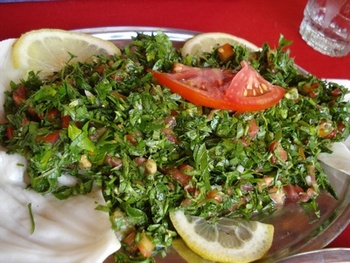 Tabbouleh
Tabbouleh
Typical holiday dishes are turkey, roast duck, "Tabbouleh" (in Levantine Arabic "little spicy"), chicken with rice, boiled wheat ("bulgur") mixed with meat, "Baklava" (a cake made with honey and nuts) and "Bûche de Noël" (Christmas cake shaped like a log). Tabbouleh is a delicious salad made with finely chopped parsley, bulgur, spring onion, olive oil, black pepper, lemon juice and different spices.
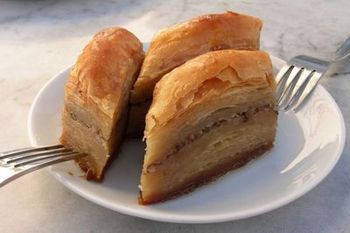 Baklava
Baklava
In Beirut people traditionally celebrate the start of new year by shooting tracer bullets over the Mediterranean Sea. After midnight many stroll in their cars along the coast. This custom of strolling is done during other holidays too.
When the child is born, the family prepares Meghli. Meghli is a traditional rice pudding. The ingredients needed for preparing this delicacy are pounded rice, sugar, caraway seed, anise seed, powdered ginger and water. Meghli is usually decorated with some blanched almonds, walnuts, pistachios etc.
The "man'oushé" or "man'oushe bi za'tar" is the most popular breakfast food of the Lebanese. It is the traditional Lebanese bread. The word man'oushé comes from "na'sh" which is term used by local bakers.
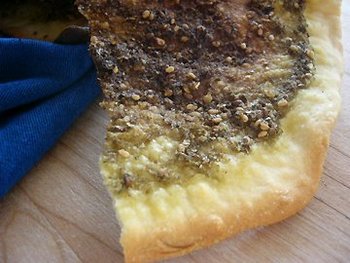 Man'oushé
Man'oushé
Bakers put a special mixture of thyme, sesame seeds and olive oil (za’tar) on the bread. The man'oushé can have cheese topping too. Salty white ‘akkawi cheese is used for this purpose.
When describing traditional Lebanese cuisine term "mouné" (in Arabic "mana" means storing) should not be missed. Mouné (preserves) are made from both fruits (jams, marmelads, syrups) and vegetables (pickling, making paste, with olive oil).
Very popular form of meal in Lebanon is "mezze". The word mezze is derived from Turkish "meze" and Persian "maze" which means taste or snack. The mezze is a group of appetizers or small dishes which is usually accompanied with beverage like arak, ouzo, raki or wine. Typical mezze includes different salads, dips, patties and stuffed grape leaves.
Mezze also has a social importance. It is a time when people gather and discuss different topics. The Lebanese especially love two types of bread. The first one is „khub“ which is pita type of bread. The second one is paper-thin bread known as „marqouq“.
The pita bread that has gone stale is used for making a salad called fattoush (fattouche, fattush). Apart from toasted or fried bread this delicacy includes tomatoes, lettuce, radish, cucumber, onion, purslane, sumac, mint, olive oil, salt and some lemon juice.
People in Lebanon drink lot of coffee ("ahweh"). Some locals say that those who do not drink coffee are going to loose nationality. Coffee drank in Lebanon is mainly Arabic (Turkish) style. It is strong and often flavoured with cardamom. Some people also add few drops of orange blossom water. The Lebanese prefer their coffee very sweet.
People prepare their coffee in a long-handled coffee pot called "rakwe". The coffee is poured straight from the rakwe to "demitasse". A demitasse is a small cup (from French "half cup"). Such a cup has capacity of 60-90 ml (2–3 fl oz).
There is also a “white coffee”. For the Lebanese it is actually a herbal tea prepared with orange blossom water. White coffee is originally from Beirut. It is usually served after meal with some candied roses petals.
In Lebanon and elsewhere in the Middle East people often drink a beverage called "Jallab". Jallab is made from dates, grape molasses and rose water. It is often served with crushed ice, pine nuts and raisins which float on its surface.
Let's now visit a Lebanese vineyard. The most popular grape varieties in Lebanon are of French origin like Cabernet Sauvignon, Merlot and Rhone varietals. Some indigenous grapes like for example Musar white exist too.
All the biggest Lebanese vineyards are located in the south of Beqaa Valley. Three most important wine producers in Lebanon are Chateau Ksara, Chateau Kefraya and Chateau Musar. Chateau Ksara started producing wine in 1857. Today it produces 70% of all wine in Lebanon.
Imagine now that it is mid-September. It is time of grapes picking. People of Lebanon use grapes to make Arak (Araq), wine, vinegar or grape molasses.
Arak is an alcoholic beverage made through distillation and is flavoured with anise seeds. Arak in its pure form is colourless. But it is rarely drank as such, straight. People drink it mixed with water - about 1/3 arak and 2/3 water. Some ice is also added.
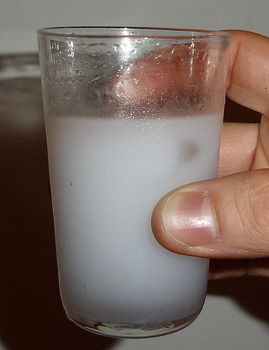 Glass of Arak
Glass of Arak
When mixed Arak gets milky-white colour. Why? Well, it is because anise in Arak includes an essential oil called anethole which is soluble in alcohol but not in water.
The grapes picking season is the most beautiful time of year for every vineyard owner. Parties are organized. Everyone is so happy.
Lebanese women prepare all kind of delicacies like for example Tabbouleh, Hummus, Babaghanough, stuffed vine leaves etc. "Hummus" (Houmous) is a dip or spread made from cooked, mashed chickpeas, "tahini" (a paste of ground sesame seeds), olive oil, lemon juice, salt and garlic. The world largest plate of hummus was prepared by 300 Lebanese chefs in the village of Al-Fanar (about 8 km east of Beirut) on the 8th May 2010. It weighted 10.5 tons. "Babaghanough" is kind of salad made of tahini with baked and after that minced eggplant, garlic and parsley.
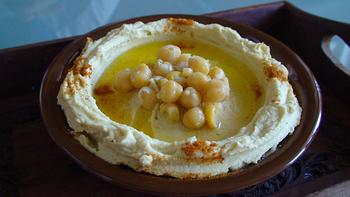 Hummus
Hummus
Festive clothes is worn. Women wear flowing skirts, shirts, long vests, veils, beautiful headdresses decorated with beads. Men wear "sherwals" (baggy shaped pants) and "labbadeh" (felt hats), colourful vests, shirts and boots.
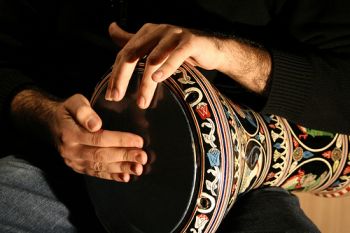 Derbake drum
Derbake drum
Traditional music is performed. Musicians use musical instruments like "derbake" (a small drum made of clay with goat skin on its top), "nay" (long bamboo flute) and "mijwiz" (short double barreled flute). They perform traditional "daloonah" tune. Daloonah also includes improvised singing.
Some men and women hold hands and start to dance. Their traditional dance is called "dabke" (dabkeh). Other people present join them by clapping their hands.
The party continues. People sing. A woman with a jug on her head appears. Others join her in kind of competition. The next of stage are the men with swords perfroming traditional swords dance.
The old man announces that the grapes juice is ready. The atmosphere reaches even higher level. There is lot of ululation. The ululation is a process of creating long, wavering, high-pitched sound by fast movement of the tongue and the uvula to show thrill, happiness. In the Middle East it is commonly performed by women.
There is a legend about how the dabke was created. In the past flat roofs of Lebanese house were covered with branches and mud. In time the top mud layer started to crack. The owner of the house put a new layer. But he needed a help to finish the job. So, he invited his neighbours to come on the roof. There they formed a line and start stomping their feet while walking. The mud layer was fixead and new dance was created. First it was known as "Al Awneh". Later it changed its name into "Daloonah" or a form of improvised singing and dancing the dabke dance.
The most famous Lebanese singer is Fairuz (1935-). Her real name is Nouhad Wadi Haddad. She is known as an "Ambassador to the Stars" and a "Neighbor to the Moon". The Lebanese especially love her songs "Behhbak Ya Lebnan" ("I love you Lebanon") and "Ya Hawa Beirut".
Lebanon has something what is called Al Zajal. Al Zajal is a form of improvised poetry. Special Al Zajal parties are organized. Zajal is usually performed by a singer who makes up the songs right at the party. They are professionals. In the past people used to invite them to sing at weddings.
Lebanese literature represents an interesting combination of French and Arab influences. The most famous Lebanese writers are Khalil Gibran (1883-1931), Emily Nasrallah (1931-) and Karim El-Koussa (1971-).
The Lebanese people love proverbs. Here is one example - "A clear conscience shines not only in the eyes".
One of folk sports of Lebanon is "kbeich". Kbeich is two men arm-wrestling. The winner becomes quite famous in local community for his strength. Popular fictional character that appears in many Lebanese jokes is Abu Abed (his full name is Abu Abed El Beyrouty). He is usually described as a guy with big moustache wearing red fez (felt hat) on his head. His best friend is Abu Steif. They spend most of their days in the Kahwat El Ejeez which is a famous coffee shop in Beirut.
Let's finish with the Sahsouh. What is it? It is rather strange tradition. It is performed on the head of the man which has just visited his hairdresser. Other people kick back side of his head with the palm of a hand. While doing this they shout "Naeeman". Before the strike sometimes people present a special Sahsouh tune or jingle. Everyone knows it and that way has enough time to get ready for the Sahsouh.